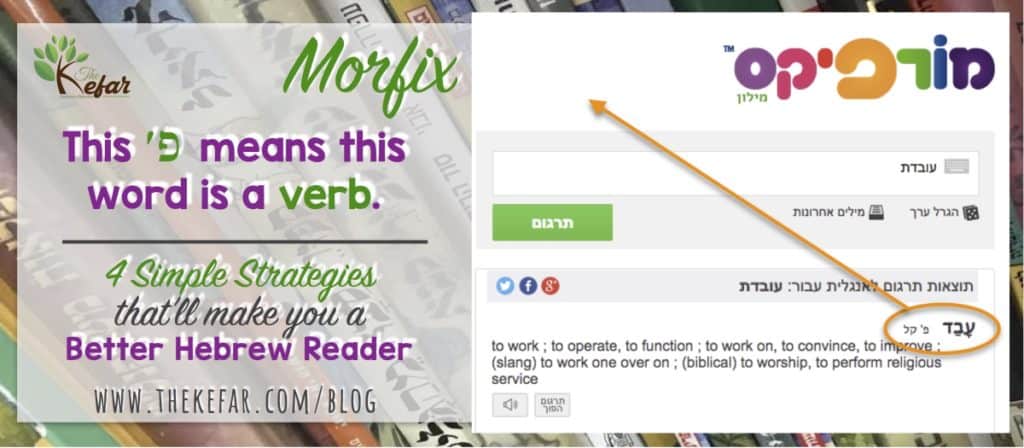One excellent way to improve your Hebrew language skills is to make time to read daily. Reading in Hebrew improves your spelling, helps you to understand Hebrew sentence structure, and of course, expands your vocabulary. Even if you’re a beginner, it’s important that you add daily Hebrew reading to your language studies.
Your Hebrew reading selection doesn’t have to be long, and it doesn’t have to be a traditional text; you can read a page from a children’s book, a poem, a Facebook post, or even a single-line quote you saw on Instagram. What’s important is that you’re learning new Hebrew words, learning about Hebrew sentence structure and grammar rules, and recognizing words and phrases that you already know.

Reading to boost your Hebrew comprehension and language skills is a little different than regular reading you would do in English, or another language you’re comfortable with. Reading for Hebrew language learning is much more intentional – you really want to pay attention to the words, and how they’re ordered. So how exactly do you read with intention? I’m so glad you asked!
I’ve broken down the Hebrew reading strategies that I use into four simple steps that will make you a better Hebrew reader. After all, reading isn’t just about being able to pronounce words – it’s about understanding what you’re seeing and saying, and these four strategies will help you do that.

Step 1: READ the Hebrew text (twice).
If you’re reading a short passage (just a few sentences), try and read the whole thing first. If this is too challenging for you, or you’re reading a longer Hebrew text, then you can read a paragraph, or just 1-2 sentences, at a time.
When you read the first time, focus on accuracy and fluency – this means making sure you’re pronouncing the Hebrew words correctly (accuracy), and reading them as smoothly as you can (fluency).
For your second reading, see how much of the Hebrew text you are able to understand. When you finish, guess what you think the passage is saying. (Even if you have no idea or don’t understand a single word – go ahead and take a guess anyway. It won’t hurt!)
*~*~* EXAMPLE *~*~*
Let’s say your sentence is: היום יום שני ואני עובדת במשרד, לא בבית.
Read it first carefully, making sure you’re pronouncing the words correctly. Then, read it again, and guess what it means. Let’s say the only words I recognize are yom, which means day; va’ani, which means and I; lo, which means no or not; and bayit, which means house. I don’t know the rest of the words, and I’m not sure why bayit has an extra beit in front of it. So I’m going to guess that this sentence says “It’s a nice day and I don’t want to be in the house.”

2. TAKE NOTES on the Hebrew words you don’t know.
For this second step, you’re going to make a note of all the Hebrew words that you don’t know, or aren’t sure of. When I say make a note, I mean literally write them down, as in put pen to paper – not on your phone. Studies have proven that the act of physically writing notes really helps you commit the information to memory. If you don’t already have one, I recommend getting a notebook that you use for Hebrew, so you can keep all your notes in one place. You can write the words in a list, making sure that you leave room to write their meanings in the next step.
*~*~* EXAMPLE *~*~*
I read the sentence twice in the first step, and guessed that היום יום שני ואני עובדת במשרד, לא בבית means, “It’s a nice day and I don’t want to be in the house.” I only knew four of the words, so now I’m going to list the rest of the words in my Hebrew notebook:
– הַיוֹם
– שֵׁנִי
– עוֹבֶדֶת
– בַּמִשְׂרָד
– בַּבַּיִת*
*I know that bayit means house, but I’m not sure about that extra beit in the front, so I added this one to my list.

3. LOOK UP the unfamiliar words.
In this third step, you’re going to look up the translations of the Hebrew words you listed in Step 2, and add the meanings to your Hebrew notebook. Hebrew words can have multiple meanings; sometimes any one will work for your translation, and other times, only one meaning will make sense in the context of the text. Just write down the first couple of translations that you’re given. (You can always come back to this if a word isn’t making sense.) You might also want to note if the Hebrew word is masculine or feminine.
One of my favorite translation tools is Morfix – it’s easy to use, accurate, and also has a free app that I have on both my phone and iPad. Another great (and free!) tool specifically for Hebrew verbs is Pealim – you can enter a Hebrew verb in any tense, and it will not only give you the verb’s meaning, but specify its tense, gender, and number (i.e. present-tense masculine singular).
HEBREW TIP #1: if you look up a verb in Morfix, it will give you the verb’s root (usually 3 letters), and the translations will start with “to ___.” There will also be a little פ next to the Hebrew root (see the image below). Once you see this, you’ll know the word is a verb, and you can check Pealim for an exact definition.
HEBREW TIP #2: If you look up a noun that starts with ב, ה, ו, כ, ל, מ, and the word is translated without minus one of those first letters, it means the first letter had a second meaning that you need to look up. Look at the picture below to see what I mean.
*~*~* EXAMPLE *~*~*
I’ve read the sentence twice, and guessed its meaning based on my understanding of a few words (step 1), and I’ve written down all the words I didn’t know or wasn’t sure about (step 2). Now, I’m going to look up the translation of each one, and write it next to the Hebrew word.
today; now, currently – הַיוֹם
second; Monday (masc.) – שֵׁנִי
work (present tense/fem/sing.) – עוֹבֶדֶת
office, bureau (מִשְׂרָד) (masc.); in, at (בְּ) word + prefix – בַּמִשְׂרָד
house, home (בַּיִת) (masc.) ;in, at (בְּ) word + prefix – בַּבַּיִת

4. TRANSLATE the text, using the definitions you looked up.
Now that you have the translations for all the Hebrew words, it’s time to translate the sentence as a whole. You’ll probably translate it word for word at first, but you should definitely shuffle things around if you need to, so that it makes sense in English. For instance, look at the Hebrew sentence גנב הילד את הפיצה. Word for word, it says, “Stole the boy the pizza,” – which of course isn’t how we’d word things in English. So you’d rework that to say, “The boy stole the pizza,” and that would be a much better – and just as accurate – translation.
HEBREW TIP #3: The verb “to be” in the present-tense is implied in Hebrew. This means you won’t see any Hebrew words for “am,” “is,” or “are,” so you’ll need to add them in yourself when you’re translating to English.
*~*~* EXAMPLE *~*~*
I’ve read the sentence twice, and guessed its meaning (step 1), written down the words I didn’t know (step 2), and looked up their translations (step 3). Now it’s time to translate the entire sentence. I’ll put in all the word options, and then choose the ones that make the most sense.
היום יום שני ואני עובדת במשרד, לא בבית
Translation Attempt #1: Today day second/Monday and I work in/at office, no/not in/at home.
I know that I need to add in “am,” “is,” or “are” on my own, since Hebrew doesn’t use the verb “to be” in the present-tense.
Translation Attempt #2: Today is day second/Monday and I work in/at office, no/not in/at home.
I’m going to assume that “day second” (or “second day,” as we say in English) is the same as Monday, so I’ll take out the other two words. I’ll use at for office, and add “the” since we usually say “I work at the office.” Not makes more sense than no here, and I’ll use at home instead of in home.
Translation Attempt #3: Today is day second/Monday and I work in/at the office, no/not in/at home.
Final Translation: Today is Monday and I work at the office, not at home.

A final optional step would be to confirm your translation using a tool like Google Translate. It can be useful for Hebrew phrases that have different meanings than their literal translations. For instance, if you looked up על הפנים as separate words, you’d get “on the face,” when really it’s a phrase that means “awful” or “lousy.” Be careful though – Google Translate is far from a perfect tool, so only use it if you’re unsure about your final translation and have nowhere else to turn. Usually, though, you can rely on the context of your Hebrew text to tell if your translation makes sense.
Also know that a Hebrew text can be translated in more than one way, and still be accurate. For instance, I could have translated our example sentence as, “Today is Monday and I am working in the office, not in the house.” and that would also be correct. So don’t worry if you do use a translation service, and the words don’t match yours exactly. There are multiple ways of saying the same thing!
Follow these four simple steps, and I guarantee your Hebrew reading [comprehension] and your vocabulary knowledge will improve over time. I’ll leave you with a practice Hebrew sentence – use these strategies to translate it, and leave your final translation in the comments below!

You can do it!
Until next time,
💙 T’helah




All I can think to say is wow! I think your info is intriguing and fascinating. You have done a great job on this article.
The boy eats pizza and drinks apple juice. Thank you, your method is working. Thanks for your info about understanding translator tools.You are so inspirating!
Ding, ding, ding – excellent job! Thank you so much for reading and for leaving such kind comments!
Wow, I feel grateful to learn the technique. It’s super helpful and easier to practice by myself.
I was struggling with Hebrew reading and writing and decided to focus on speaking only, rather than reading and writing. Your post inspires me and gives me more confidence. Deeply appreciate!